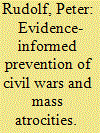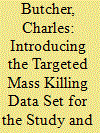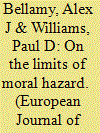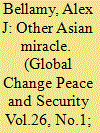|
|
|
Sort Order |
|
|
|
Items / Page
|
|
|
|
|
|
|
| Srl | Item |
| 1 |
ID:
144700


|
|
|
|
|
| Summary/Abstract |
This article examines the failure of the Nigerian government to exercise its responsibility to protect (R2P) populations from mass atrocities in the wake of Boko Haram's violent and persistent attacks against civilians in north-east Nigeria. After the abduction of 276 schoolgirls on 14 April 2014, the affected communities engaged directly in protecting their villages and families. Another murderous and devastating attack on Baga in January 2015 and the abduction of over 400 women in Damasak in March 2015 continued to expose the governmental failure to protect people at risk of losing their lives. This article examines the dynamics of the people's response to the crisis and investigates whether this response could be conceptually defined as a ‘fourth pillar’ of R2P, when a state – even in collaboration with the international community – is unable to live up to its R2P. Certainly, such a phantom ‘fourth pillar’ is symbolic and should not be used in any way by governments to re-delegate their first pillar primary R2P.
|
|
|
|
|
|
|
|
|
|
|
|
|
|
|
|
| 2 |
ID:
146684


|
|
|
|
|
| Summary/Abstract |
The prevention discourse in all its forms has tended to ignore or at least downplay the epistemic problems with prevention. Forecasting political violence is not as easy as the debate on early warning often assumes. Effectively forestalling political violence and mass atrocities is much more difficult than the often used rhetoric of a ‘tool box’ implies, which creates the impression that one knows what works. An evidence-informed prevention policy needs to be aware of the limits of our knowledge, but at the same time knowledgeable of what social science research can provide – even if the results are provisional, often controversial and fraught with methodological problems.
|
|
|
|
|
|
|
|
|
|
|
|
|
|
|
|
| 3 |
ID:
103255


|
|
|
| 4 |
ID:
173141


|
|
|
|
|
| Summary/Abstract |
This article describes a new data set for the study of genocide, politicide, and similar atrocities. Existing data sets have facilitated advances in understanding and policy-relevant applications such as forecasting but have been criticized for insufficient transparency, replicability, and for omitting failed or prevented attempts at genocide/politicide. More general data sets of mass civilian killing do not typically enable users to isolate situations in which specific groups are deliberately targeted. The Targeted Mass Killing (TMK) data set identifies 201 TMK episodes, 1946 to 2017, with annualized information on perpetrator intent, severity, targeted groups, and new ordinal and binary indicators of genocide/politicide that can serve as alternatives to existing measures. Users are also able to construct their own indicators based on their research questions or preferred definitions. The article discusses the concept and operationalization of TMK, provides comparisons with other data sets, and highlights some of the strengths and new capabilities of the TMK data.
|
|
|
|
|
|
|
|
|
|
|
|
|
|
|
|
| 5 |
ID:
123696


|
|
|
|
|
| Publication |
2013.
|
| Summary/Abstract |
AbstractThe purpose of this article is to question some basic assumptions regarding reconciliation after wars and mass atrocities. Indeed, how can numerous policy-makers, practitioners, and scholars contend that reconciliation is necessary while it is often distrusted and rejected by victims? Are there not cases where calls for reconciliation would prove to be fruitless and even detrimental for peace and/or democracy? To answer these questions, it is worth looking at the interactions between reconciliation and negotiation. Beyond a theoretical interest, this question has a direct impact for practitioners; a better understanding of the issue is actually a sine qua non condition for more efficient interventions. In terms of methodology, this study refers to various examples as illustrative cases (Afghanistan, Rwanda, South-Africa, and the Franco-German case). Its objective is not to capture the complexity of each case study but to determine to what extent reconciliation can be considered as negotiable.
|
|
|
|
|
|
|
|
|
|
|
|
|
|
|
|
| 6 |
ID:
117057


|
|
|
|
|
| Publication |
2012.
|
| Summary/Abstract |
Advocates of moral hazard theory argue that the 'responsibility to protect' causes genocidal violence that would not otherwise occur. After summarizing the main elements of the moral hazard approach, this article demonstrates that there is no empirical evidence to support the general claim that the 'responsibility to protect' is a remote cause of genocide. This is followed by an analysis of the conflicts in Bosnia, Kosovo and Darfur which demonstrates that moral hazard does not provide a plausible account of the proximate causes of genocidal violence in these cases. We suggest that a major part of the explanation for why moral hazard theory performs so badly is its reductionist account of the dynamics of armed conflict and its simplistic understanding of the dynamics of provocation.
|
|
|
|
|
|
|
|
|
|
|
|
|
|
|
|
| 7 |
ID:
127858


|
|
|
|
|
| Publication |
2014.
|
| Summary/Abstract |
East Asia has a long history of genocide and mass atrocities. For much of the Cold War, East Asia was one of the world's most violent regions, experiencing multiple outbursts of mass killing. Since the end of the Cold War, however, the region has been transformed thanks to another Asian miracle. There are now fewer cases of genocide and mass atrocities in East Asia today than at any point in history for which we have reliable records. This article demonstrates and then tries to account for the dramatic decline of mass atrocities in East Asia. It argues that the decline was enabled by a combination of three major structural changes: reduction in the selection of mass atrocities as a weapon of war, increase in incomes, and progress towards democratization combined with the emergence of new ideas about sovereignty and their accommodation with existing principles of non-interference. Together, these structural and ideational changes created a changed regional context of increased costs and reduced payoffs for the commission of mass atrocities.
|
|
|
|
|
|
|
|
|
|
|
|
|
|
|
|
| 8 |
ID:
087992


|
|
|
|
|
| Publication |
2009.
|
| Summary/Abstract |
Written prior to the release of the UN Secretary-General's report on implementing the Responsibility to Protect (R2P), this article examines the effort to translate the principle from words into deeds. It begins by noting a post-2005 "revolt" against the principle in which a number of states expressed skepticism about the principle and its use in different settings. This revolt, the article contends, was largely a product of the continuing association between R2P and humanitarian intervention. This association was, in turn, caused by a combination of misplaced commentary and the International Commission on Intervention and State Sovereignty's focus on the intervention question. This article maintains that building consensus on the R2P requires a shift in emphasis and proposes three avenues: clarifying the nature of prevention, developing practical measures, and proposing modest proposals for institutional reform.
|
|
|
|
|
|
|
|
|
|
|
|
|
|
|
|
| 9 |
ID:
123260


|
|
|
|
|
| Publication |
2013.
|
| Summary/Abstract |
This article argues that the Responsibility to Protect (RtoP) adds value to international efforts to protect populations from genocide and mass atrocities, but not in the ways commonly thought. It suggests that RtoP is not particularly effective as a 'rallying call' that mobilises action in cases where international society may be initially reluctant to act. Where it does add value is in helping to reshape states' identities and interests such that consideration of the protection needs of populations, in relation to the threat of genocide and mass atrocities, has been internalised to some extent by the UN Security Council. As such, RtoP is best seen as being a 'habit former'. The principle does not, however, determine particular behaviours or guarantee international consensus because decision-making is heavily influenced by contextual factors. The argument proceeds in three parts. The first examines instances where RtoP has been invoked since early 2006. The second explores the role of context in shaping how the UN Security Council responds to particular crises. Finally, to amplify the points made in these sections, the third section considers the UN Security Council's response to the crisis in Somalia after 2006.
|
|
|
|
|
|
|
|
|
|
|
|
|
|
|
|
| 10 |
ID:
086978


|
|
|
|
|
| Publication |
2009.
|
| Summary/Abstract |
The Declaration on 'the responsibility to protect' (R2P), unanimously endorsed by the Security Council in April 2006, identified both national and international responsibilities in relation to genocide, ethnic cleansing, war crimes and crimes against humanity. This was highly significant in appearing to accept that the prevention of mass atrocities was a legitimate international concern. Subsequently, there has been some disappointment about the limited practical impact of R2P, and also anxiety that its progress may be impeded by the fear that it is designed to legitimise military intervention. However, this article concentrates on a different concern. Arguing that an earlier version of R2P (in the International Commission on Intervention and Sovereignty of 2001) linked the issues with those of human security and development, it suggests that the contemporary focus is far narrower, undermining its critical potential with regard to the policies of the global North and reducing its appeal to developing countries.
|
|
|
|
|
|
|
|
|
|
|
|
|
|
|
|
| 11 |
ID:
141226


|
|
|
|
|
| Summary/Abstract |
To date, little attention has been paid to the question of how episodes of mass killing are terminated. This has allowed several misconceptions, such as the notion that external armed intervention is a principal form of ending, to arise and profit. This study presents preliminary findings from a survey of cases of state perpetrated mass killing since 1945. It examines the forms of ending, finding that around half end only when the perpetrators themselves decide to end the killing, usually because they have accomplished their goals. It also explores the relationships between modes of termination and lethality and the resilience of different types of ending and offers insights into the implications for policy of some of these findings. It argues that foreign armed intervention is extremely rare and does not deserve, therefore, to be the common ‘go to’ option of advocates and analysts. Instead, presuming that armed intervention is off the table, it is more important to think in terms of what can be done to shape the perpetrators’ incentive structures or encourage internal dissent within the perpetrating elite. Finally, it shows that there is no easy overlap between what is morally palatable and what saves lives. Arming rebels may be morally pleasing, but may lead to protracted civil wars with atrocities – the worst of all outcomes. Likewise, negotiating to secure the state perpetrators’ core interests may feel immoral but might stop the killing and save lives.
|
|
|
|
|
|
|
|
|
|
|
|
|
|
|
|
|
|
|
|
|